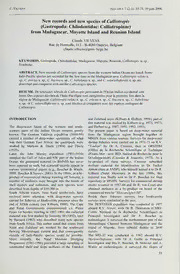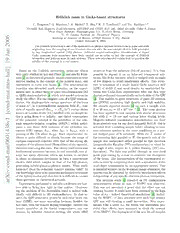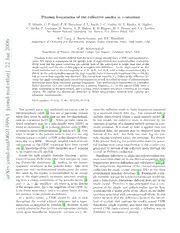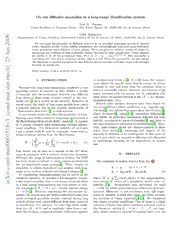
The Structure and Properties of Color Spaces and the Representation of Color Images (Synthesis Lectures on Image, Video, and Multimedia Processing) PDF
130 Pages·2009·1.481 MB·English
Most books are stored in the elastic cloud where traffic is expensive. For this reason, we have a limit on daily download.
Preview The Structure and Properties of Color Spaces and the Representation of Color Images (Synthesis Lectures on Image, Video, and Multimedia Processing)
Description:
This lecture describes the author's approach to the representation of color spaces and their use for color image processing. The lecture starts with a precise formulation of the space of physical stimuli (light). The model includes both continuous spectra and monochromatic spectra in the form of Dirac deltas. The spectral densities are considered to be functions of a continuous wavelength variable. This leads into the formulation of color space as a three-dimensional vector space, with all the associated structure. The approach is to start with the axioms of color matching for normal human viewers, often called Grassmann's laws, and developing the resulting vector space formulation. However, once the essential defining element of this vector space is identified, it can be extended to other color spaces, perhaps for different creatures and devices, and dimensions other than three. The CIE spaces are presented as main examples of color spaces. Many properties of the color space are examined. Once the vector space formulation is established, various useful decompositions of the space can be established. The first such decomposition is based on luminance, a measure of the relative brightness of a color. This leads to a direct-sum decomposition of color space where a two-dimensional subspace identifies the chromatic attribute, and a third coordinate provides the luminance. A different decomposition involving a projective space of chromaticity classes is then presented. Finally, it is shown how the three types of color deficiencies present in some groups of humans leads to a direct-sum decomposition of three one-dimensional subspaces that are associated with the three types of cone photoreceptors in the human retina. Next, a few specific linear and nonlinear color representations are presented. The color spaces of two digital cameras are also described. Then the issue of transformations between \emph{different} color spaces is addressed.
See more
The list of books you might like

Shatter Me Complete Collection (Shatter Me; Destroy Me; Unravel Me; Fracture Me; Ignite Me)
Mafi Tahereh
·997 Pages
·2014
·5.04 MB

The Subtle Art of Not Giving a F*ck
Mark Manson
·224 Pages
·2016
·1.26 MB

The Spanish Love Deception
Elena Armas
·2021
·6.45 MB

Credence
Penelope Douglas
·487 Pages
·2020
·0.86 MB

The Power of Premonitions
Larry Dossey
·2009
·0.6012 MB

Totemismo hoje
Claude Levi-Strauss
·111 Pages
·1975
·7.6 MB

Del profumo dei croissants caldi e delle sue conseguenze sulla bontà umana. 19 rompicapi morali
Ruwen Ogien
·272 Pages
·2012
·4.054 MB

Rédiger un texte académique en français
Garnier Sylvie, Savage Alan D.
·256 Pages
·2011
·96.3435 MB

BY ORDER OF THE COMMANDER FAIRCHILD AIR FORCE BASE AIR FORCE INSTRUCTION 21 ...
55 Pages
·2012
·0.77 MB

COMESA 261: Textiles - Natural fibres - Generic names and definitions
Common Market for Eastern and Southern Africa (COMESA)
·2006
·1.9 MB

Die Acht vom großen Fluß II. Die unheimliche Vogelinsel. ( Ab 10 J.)
Gabriele Kuhnke
·123 Pages
·1998
·0.96 MB

New records and new species of Calliotropis (Gastropoda : Chilodontidae
Claude Vilvens
·2006
·6.6 MB

case nuiviber: 2015ca004377 division: ah
40 Pages
·2015
·3.35 MB

01102007-Minutes-Library
Town of Arlington Massachusetts
·0.13 MB

Frohlich mass in GaAs-based structures
C. Faugeras
·0.24 MB

Pinning frequencies of the collective modes in $α$-uranium
B. Mihaila
·0.3 MB

On the diffusive anomalies in a long-range Hamiltonian system
Luis G. Moyano
·0.7 MB

The Reach of a Chef: Beyond the Kitchen
Ruhlman, Michael
·2006
·0.475 MB

CA DOJ Gun Models Approved by Device Manufacturers
317 Pages
·2002
·2.09 MB

Electron transport through asymmetric ferroelectric tunnel junctions: current-voltage characteristics
Natalya A. Zimbovskaya
·0.17 MB

British by AUTHOR
11 Pages
·2021
·0.11 MB

C.A. No. 12088-12089/2018
36 Pages
·2017
·0.33 MB

Union Government, Extraordinary, 1993-01-29, CSL, Ref. CSL
Government of India
·4 Pages
·0.08 MB
Most books are stored in the elastic cloud where traffic is expensive. For this reason, we have a limit on daily download.

